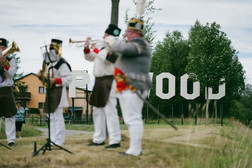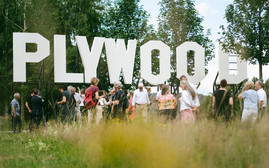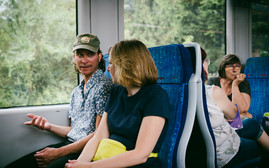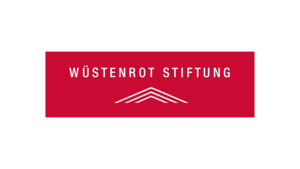Jay Gard: Plywood
Olbernhau


The sculpture, made of sheet steel and powder-coated in white, was created by artist Jay Gard, who was born in 1984, grew up in Karl-Marx-Stadt/Chemnitz and now lives in Berlin. The sculpture spells out the word “plywood”. The wood is simulated by metal, and the illusion is intensified by the use of the iconic typography of the “Hollywood” sign, which has identified the district in Los Angeles/USA, famous for its legendary film studios, since 1921.
In many ways, Gard’s sculpture at Olbernhau railway station seems to pretend to be something that, in terms of material, it is not. In fact, it is a demonstrative presentation of linguistic and visual symbols. The playful combination of symbols reveals the looseness of the relationship between many linguistic or visual symbols and the meanings they convey. For example, the seven letters of the word plywood could be used to create 46 (English) words with a wide variety of meanings.
Through its placement at Olbernhau railway station, Plywood symbolises the interwoven processes of transformation and combination, and the evolving significance of economic and cultural elements and symbols in Olbernhau. During the GDR period, it was a highly innovative and flourishing centre of wood production through the successful VERO toy factory. After German reunification, the Erzgebirge town experienced a major economic and cultural decline in the 1990s.
Jay Gard
Plywood
In Olbernhau, railway station
Material: powder-coated copper
Size: 8 x 4 x 1,80 m
Acquired with the support of the Leinemann Stiftung für Bildung und Kunst. Set up with the support of the town of Olbernhau.
Address:
Car park at the Rübenauer Weg / Brandauer Straße level crossing
near Olbernhau railway station
09526 Olbernhau
to the location on Google Maps
There is a lot to discover at the PURPLE PATH! Experience tips presented by the Tourismusverband Erzgebirge e.V.













































